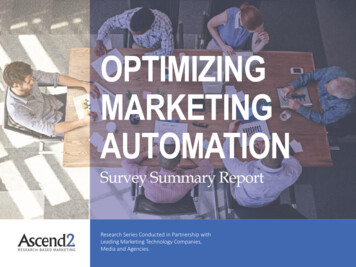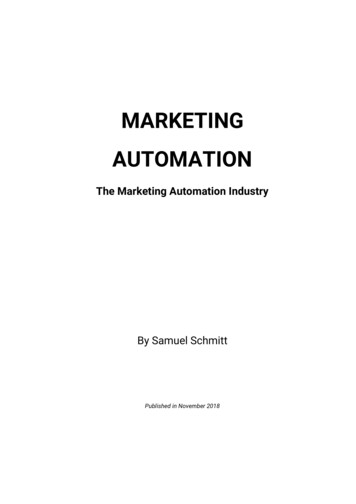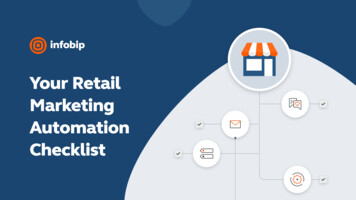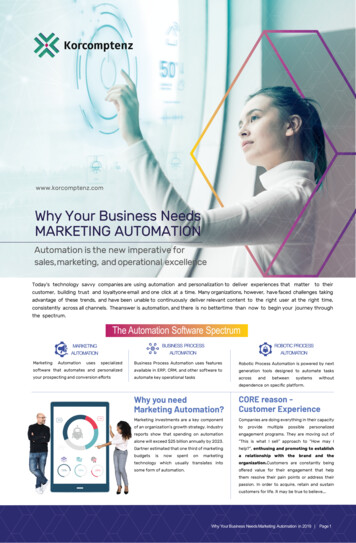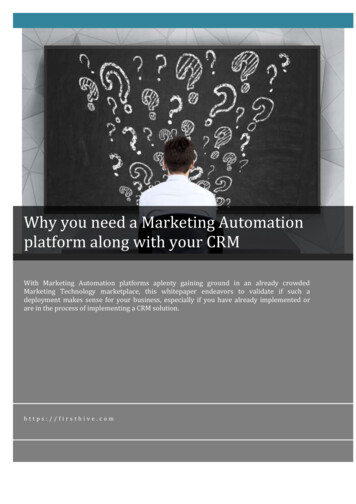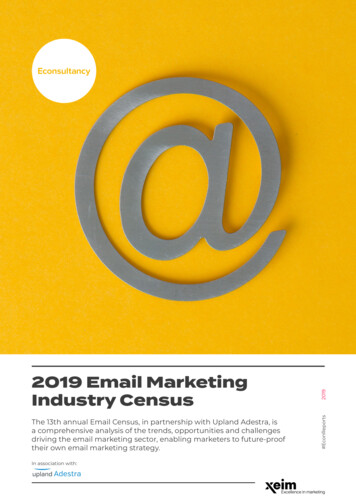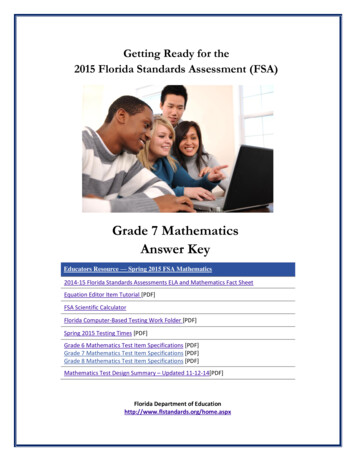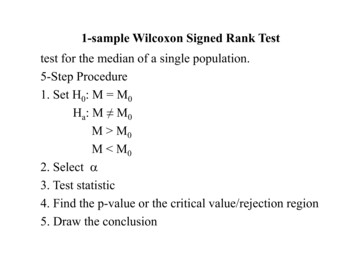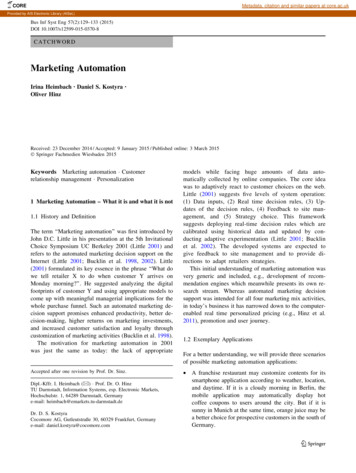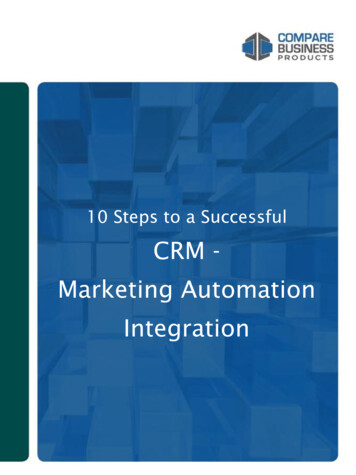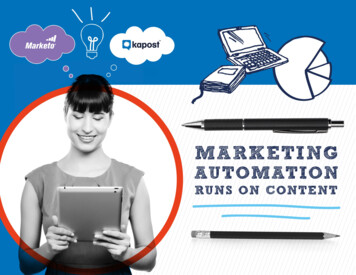
Transcription
1 . Marketing Automation Runs on Content
TABLE OF CONTENTS: ARKETING AUTOMATION RUNS ON GREATMORIGINAL CONTENT . 03 GLOSSARY OF MARKETING AUTOMATION TACTICS . 04 NOW YOUR BUYERS, CREATE MARKETING SPECIFICALLYKFOR THEM . 06Buyer Personas Marketing Automation Content PPEAL TO YOUR BUYER AT VARIOUS SALES STAGES . 09ASales Stages Marketing Automation Content REATE CONTENT TYPES THAT RESONATE WITH HOWCYOUR BUYER GETS INFO . 12Diversity of Content Marketing Automation Content RITE BETTER EMAILS . 15W Email Marketing Automation Content YNC UP THE PRODUCTION AND DISTRIBUTIONSOF MATERIALS . 18Alignment of Teams Marketing Automation Content T RACK WHAT MATTERS: REVENUE, INFLUENCE,REACH, GROWTH . 22Analytics Marketing Automation Content THE ROAD TO MARKETING GREATNESS . 252 . Marketing Automation Runs on Content
MARKETING AUTOMATION RUNS ONGREAT ORIGINAL CONTENTMarketing automation is one of the fastest growingtechnology segments in business. More than a quarter ofall Fortune 500 companies have invested in the software,and analysts predict it will grow to a 4.6 billion industryby 2016.Give your marketing the competitive advantage: build a contentoperation into your marketing automation strategy from the get-go.But there’s a problem.More than three-quarters of those who’ve invested in marketingautomation say that investing in processes and content isinstrumental to success with the technology. In other words, toconnect with the right buyers at the right time, companies needto combine a streamlined content operation—which includesprocesses for producing, distributing, and analyzing content—with marketing automation software. ontent is the key to keeping your marketing automation fromCgoing idle. All of your content—from emails to whitepapers tovideos to research reports—plays a role in activating marketingautomation tactics, from lead nurturing to deep dive reporting.For instance: hat do you send to your leads or qualified opportunitiesWto keep them moving down your pipeline? Content. hen you examine the many “touches” from marketingWthat have influenced a purchase, what are you actuallytracking? Content.3 . Marketing Automation Runs on Contentof those who’ve invested inmarketing automation say thatinvesting in processes andcontent leads to greater success.
GLOSSARY OF MARKETINGAUTOMATION TACTICSLet’s recap a few of the most powerful tactics marketingautomation provides: L EAD NURTURING is the process of building relationshipswith potential buyers—regardless of how ready they are tomake a purchase. The goal of lead nurturing is to developtrust and establish lines of communication, eventuallyearning that buyer’s business. LEAD SCORING is a method of identifying and rankingyour potential buyers. Using marketing automation, you canassign values to activities that indicate buying interest—suchas visiting particular pages on your website, downloadingparticular content assets, or engaging at in-person events.When a prospect reaches a certain score, he or she ispassed along to sales. SEGMENTATION is the process of dividing your audienceinto segments in order to target each segment with the mostrelevant possible content. You might segment your audienceby demographics, firmographics, behaviors, or all three.Once you’ve defined your segments, your marketingautomation delivers and presents segment-specificcontent to your buyers.4 . Marketing Automation Runs on Content LONING AND TOKENS help marketers streamlineCactivities, avoiding unnecessary repetition. Marketingautomation allows marketers to clone entire programs—multiple emails, landing pages, links, and segments—whiletokens allow you to auto-populate your messages withpersonalized information like names, dates, and times. I NTELLIGENT CONTENT DELIVERY acknowledges thatcontent is the fuel for your lead nurturing strategy. The rightcontent at the right time is often the difference between an“unsubscribe” and a “tell me more.” That’s why, if you’recontinually creating new content, you’ll want to easily addit to campaigns, and ensure that the right people receive it.
GLOSSARY OF MARKETINGAUTOMATION TACTICSSome solutions make it easier than others to put thefreshest content in front of prospects, add content to nurturecampaigns, and avoid sending too many nurture emails—or duplicates—to your database. REAL-TIME PERSONALIZATION helps marketerstarget their website visitors in the same way they targetrecipients of email campaigns. By identifying each visitor’sbehaviors, demographics/firmographics, and profiles, realtime personalization can then serve up the most relevantcontent to each person who visits your website. Note thatadvanced real-time personalization tools can performthis function for both known and anonymous prospectsand customers. ALES TEAM NOTIFICATIONS alert the sales teamSabout prospects who are ready to buy. Ideally, themarketing and sales team come to an agreement aboutwhich developments should trigger a notification to sales—it might be when a prospect reaches a certain lead score,completes an activity, or fits a specific profile. Oncethese have been defined, your marketing automationwill automatically send the alerts, ensuring that salesimmediately follows up on hot leads. CALENDARS help marketers coordinate multiple programsand activities, getting the whole department on the samepage. Calendars within some marketing automationplatforms also allow you to deploy programs, which meansthat you can plan, adjust, schedule, and pull the trigger onprograms—all in one place. EEP DIVE REPORTING gives marketers the ability toDprove their ROI. While the success of marketing campaignswas once difficult—if not impossible—to measure, marketingautomation has empowered marketers to definitively tietheir activities to closed-won deals. PROGRAM LIBRARIES are repositories of pre-built,verified best practices and programs. Marketingautomation platforms with these libraries help you avoidreinventing the wheel, getting your programs up andrunning quickly.5 . Marketing Automation Runs on Content
KNOW YOUR BUYERS, CREATEMARKETING SPECIFICALLY FOR THEM.Buyer Personas Marketing Automation ContentThe most successful marketing campaigns are created withspecific buyers in mind. That means the modern marketer mustcreate unique content that addresses the real concerns, needs,interests, likes, and dislikes of their buyers. To identify andunderstand these buyers, marketers create “buyer personas.”Most marketers find that they have multiple types of buyers,each of which needs a dedicated persona.BUYER PERSONAS are research-based representations ofyour buyers, identifying who they are and how they act.Once you’ve carefully researched and built out your buyerpersonas, you can create content geared specifically towardeach one, and deliver that content using marketing automationsoftware. The strategy works because, as you can imagine,a CEO might have very different consumption habits than amanager, and very different challenges to address as well.But remember, while marketing automation can segment yourlists by persona, you still need to build the persona-specificcontent it delivers.6 . Marketing Automation Runs on ContentHere’s how to create custom content around your buyer personas:STEP 1: Group Your Buyers into Defined PersonasIdentify 3–5 buyer personas that faithfully represent yourcustomer base, getting as granular as possible about who thesepersonas “are” and what they care about. Use market research,demographics and firmographics to understand the likes, dislikes,concerns, qualms, or interests of key buyers.Need Help Getting Started?Marketo has developed brilliant buyer personaworksheets. Fill them out, and you’re done.
KNOW YOUR BUYERS, CREATEMARKETING SPECIFICALLY FOR THEM.STEP 2: Map Current Content to PersonasSTEP 3: Identify Content GapsAfter compiling a list of buyer personas, review your existingcontent. Do you already have content (such as whitepapers,webinars, ebooks, blog posts, presentations, or sales collateral)that adequately addresses common buyer concerns? Try using afree content auditor tool, like the Kapost Content Auditor, to locateall of your existing online content and tag those pieces by keybuyer personas. This process categorizes your content assets bypersona and allows for future use, reuse, and re-purposingof assets.Based on the results of your content persona audit, identify gaps inyour content as they emerge. Note what types of assets could becreated to fill those gaps.STEP 4: Build Email Segments in Marketing Automationby PersonaIn your marketing automation platform, build email segmentsbased on each persona. You could create something simple, suchas one nurture track for each identified persona, or you can getcrafty with your segmentation rules, factoring in complexities like abuyer’s place in the sales cycle.STEP 5: Get StartedOnce you’ve created your segments, set up your marketingautomation to automatically send identified content assets to therelevant personas. Targeted content built to match specific buyerpersonas has been shown to increase conversion rates, openrates, and click-through rates.7 . Marketing Automation Runs on Content
KNOW YOUR BUYERS, CREATEMARKETING SPECIFICALLY FOR THEM.How Content Tailored Around Buyer Personas Amplifies Marketing Automation:Content developed to target specific personas fuels your marketing automation. Itpersonalizes your messaging to each lead at just the right moment in their journeys,demonstrating that your company is highly in tune to your buyers’ needs.With persona-driven content, you can more effectively implement the followingmarketing automation tactics:1. LEAD NURTURING:Automated delivery of content targeted tospecific buyer personas allows marketersto engage and track the behaviorof leads, providing buyers with anopportunity to better understand thetopics, themes, and ultimately, the solutionsthat address their specific needs.3. RELEVANCE OFCOMMUNICATIONSUse buyer personas to keep contentrelevant. For example, executive-levelcontent will be useful to the VicePresident of Marketing, but perhapsnot a marketing specialist.2. SEGMENTATION:4. DYNAMIC CONTENT /FIELD MERGE:Use unique profile or demographic/firmographic data to inform emailsegmentation. Create lists aroundspecific needs, interests, or concerns.Personalize, target, and automate contenton forms or pages that have dynamiccontent fields. Use buyer personas tokeep messaging targeted.8 . Marketing Automation Runs on Content5. P ROGRAM LIBRARIES:Save campaigns that work for certainbuyer personas in program libraries toavoid starting from scratch.
APPEAL TO YOUR BUYER ATVARIOUS SALES STAGESSales Stages Marketing Automation ContentSimilar to mapping content to personas, understanding each stageof the buyer’s journey—including the unique behaviors, questions,and concerns that prospects have at each of those stages—allowsmarketers to deliver more relevant, personalized, and timelymessaging to buyers.By researching and evaluating the content that guides buyers intothe top of the funnel, then propels them toward purchase at thebottom of the funnel, marketers can optimize their communicationfor faster sales.Marketing automation tracks buyer behavior. It then allows forthe automated delivery of relevant information to buyers basedon their behavior and movement from one sales stage to another.But where does that relevant information come from? Content,of course. Without content mapped to specific sales stages,marketers miss the opportunity to build trust throughthought leadership.The best content marketingcompanies are 25% more likely tohave a process in place for aligningmarketing content with marketingand sales funnel stagesHere are the steps to effectively track and deliver content by salesstage using marketing automation:STEP 1: Identify Your Buyers within Sales StagesThe easiest way to start mapping content to sales stages is to startwith closed-won deals and work your way back through theirbuyer journey. Using analytics tools like content scoring and leadscoring, identify key conversion points in your sales funnel. Identifywhich online behaviors indicate a prospect is ready to hear fromsales. Ask questions like: o downloads, event registrations, or product demoDrequests indicate someone has moved from the middleto the bottom of the funnel? o different interactions with different content types resultDin different lead scores?By working backward and finding patterns in behaviors andinterests—at every step in the buyer’s journey, from awareness toclose—you’ll be able to identify where buyers are in their path topurchase. Once you understand these elements, segment buyersinto specific marketing and sales stages to better tailor yourcontent delivery.
APPEAL TO YOUR BUYER ATVARIOUS SALES STAGESSTEP 2: Map Current Content to Sales StagesNow that you know which online behaviors result in conversions,take a close look at the content you’ve already produced. Foreach sales stage, identify 5–10 unique content assets that could berelevant to buyers at each step toward purchase.STEP 3: Identify Gaps and Create Content to Fill ThemStep 2 gives you visibility into which stages are under-resourcedby your content; Step 3 is identifying and filling those gaps.For example, you might have great case studies and third-partyreports for the bottom of your sales funnel, but nothing thatconnects best practices with your product offerings for mid-funnelcommunications. Identify all the content gaps in your funnel andbuild a strategy for creating content to fill them.STEP 4: Map Email Segments in Marketing Automation toSales StagesAfter you’ve found and created content to match the needs ofbuyers in each stage, build out specific email segments and leadscoring programs within your marketing automation. Developsmart lead scoring programs to help you track buyer behaviorand identify signs that a buyer is getting closer to a purchase.You’ll want to assign scores to your content—the more closelyan asset aligns to your product or service, the more highly itshould be scored. Generally speaking, when a buyer downloadscontent that is more product-centric, that buyer is more likely to beinterested in your product. On the flip side, more broadly focused,early-stage content is weighted more lightly.STEP 5: Send Identified Content to the Relevant Sales StagesTime to activate your campaign! Using the steps above, sendrelevant content campaigns to specific buyers as they navigatetheir purchase decision.10 . Marketing Automation Runs on Content
APPEAL TO YOUR BUYER ATVARIOUS SALES STAGESHow Content Designed for Specific Stages Fuels Marketing Automation:1. LEAD SCORING:By understanding the types of information(content) your buyers care about asthey move from awareness to purchase,strategically score buyer behavior andtrack key indicators on each of your leads.2. SALES TEAM NOTIFICATIONS:Automate the delivery of informativecontent to your buyers, and set up yourmarketing automation platform to notifythe appropriate sales developmentrepresentative when that buyer hasexhibited signs of purchase. Sales repscan also see which content that buyertouched, preparing them to tailorconversations to each buyer’s needsand interests.11 . Marketing Automation Runs on Content3. RELEVANCE OFCOMMUNICATIONSMap content to sales stage to addressunique concerns as buyers move from topof funnel to close.4. DEEP DIVE REPORTING:Interactions with content—whether thatbe in the form of web copy, call toaction buttons, or blogs—indicate andmonitor movement from one sales stageto another. Establish unique landingpages and analytics tracking to see whichcontent is driving the biggest results.
CREATE CONTENT TYPES THAT RESONATEWITH HOW YOUR BUYER GETS INFODiversity of Content Marketing Automation ContentDifferent people have different preferences when it comes toconsuming content. For instance, some people prefer to watchvideos on a tablet, while others prefer to read blogs on a PC.Your buyer personas should give you insight into which formatsyour audience prefers, but experimenting with a variety of contenttypes (and testing which work best) is an important best practice.Providing a variety of content types allows marketers to: I dentify the most effective content assets based onpersona and buying stage eep users engaged by mixing up the typesKof content delivered T ake advantage of the strengths of specific formatsfor delivering a certain kind of messaging orcontent experienceBut how can you combine different types of content withmarketing automation for the best results? Here are the stepsyou need to take.STEP 1: Perform a Content AuditFirst, perform a content audit to inventory which content assetsand types your company has already published.A content audit gives you insight into which content types youalready have on hand, provides your marketing automation teamwith easy access to all of these assets in a single repository,and helps you identify which content types work best for yourtarget audience.Your content audit doesn’t have to be along, scary process. Give the free tool,the Content Auditor, a shot.12 . Marketing Automation Runs on Content
CREATE CONTENT TYPES THAT RESONATEWITH HOW YOUR BUYER GETS INFOSTEP 2: Map and Fill Content Type GapsUse marketing automation in conjunction with social media,content marketing, and CRM platforms to understand whichcontent types perform best with your target audience. Which type drives the best traffic? Which type converts prospects to leads? Which type is tied to the highest revenue? How does each type compare to the rest?As you answer these questions, strategize to create more ofthe content types that work for your buyers at every stage ofthe funnel.13 . Marketing Automation Runs on ContentSTEP 3: Build Marketing Automation Rules to Deliverthe Right ContentMarketing automation gives you insight into your buyers, thenhelps you act on that knowledge by setting up systems fordelivering the most effective kinds of content to each segment.As buyers interact with your content, you learn more aboutthem, making it easier to deliver increasingly tailored content.To increase relevance, you can automate the types of contentthey receive based on what they’ve engaged with in the past.STEP 4: Take Risks!Create a steady stream of the content types you know resonatewith your buyers. But don’t stop there. Wow your leads byexperimenting with new content types, such as interactive webpages, GIFs in emails, or even activity books. You won’t knowwhat works until you try it, and providing interactive, interestingcontent types will elicit emotions such as curiosity, surprise, anddelight from your buyers.
CREATE CONTENT TYPES THAT RESONATEWITH HOW YOUR BUYER GETS INFOHow a Variety of Content Types Fuels Marketing Automation:1. LEAD SCORING:3. DYNAMIC CONTENT:Certain content types or assets mayindicate that a lead is closer to purchase,and you can score interactions with thiscontent more highly.By tracking the content types buyersmost commonly engage with, you canserve up more of the same assets onvaluable topics.2. CAMPAIGN LAUNCH:Hit prospects with messaging alignedaround a target theme or product launch,but in various formats that will resonate.14 . Marketing Automation Runs on Content
WRITE BETTER EMAILSEmail Marketing Automation ContentOn any given day, the average customer will be exposedto 2,904 media messages, will pay attention to 52, and willpositively remember only four. The point? You have to producehigh quality if you’re going to stand out among the quantity ofmessages bombarding your buyers.The emails you send through your marketing automation arepieces of content in their own right—but they’re also importantgateways to larger content assets. Their success depends on firstcapturing attention, then delivering relevant messaging, and finallydriving the recipient to take action.Too often, emails aren’t considered content. They’re written by adifferent team, or they’re created without the same standards onemight use to create a blog post or article.The fact of the matter is that well-written, personalized, andrelevant emails spur action, and ensure you’re getting the mostout of your marketing automation investment.Here’s how to create better emails that inspire your audience toengage with your company:STEP 1: Write Stand-Out Subject LinesYour subject line is your first impression. Be clear and direct. Tryto tell the recipient exactly what they’ll gain from opening theemail. Limit your subject lines to 50 characters or less. Start bybrainstorming 5-10 subject lines for each email, then choose theone that resonates best.STEP 2: Be Brief (the Shorter the Better)Every email should be powerful and compelling to your targetaudience. Like in subject lines, be concise and punchy with yourmessaging. Use bullet points, bolding, and images to spice upbland copy so you can capitalize on the first few seconds ofbuyers’ attention—these may be the only seconds you get.Personalized emails increase bothtransaction and revenue rates by 6x.They also deliver 29% higher uniqueopen rates and 41% higher uniqueclick-through rates.15 . Marketing Automation Runs on Content
WRITE BETTER EMAILSSTEP 4: Implement Personalization StrategiesPersonalization has been shown to increase open and clickthrough rates in email, and marketing automation makes it easyto add this powerful touch to your email communications.Common personalization tactics include:STEP 3: Choose Effective Calls to Action, and Fewer of ThemUse one call to action (such as a link to an asset or a landingpage) per email, and avoid any unrelated links that will distractfrom the main goal of your email. An email cluttered with links willonly confuse your buyers, but linking to the one asset or landingpage in multiple places will increase the chances that your buyerwill click.Include a contextual link in the first lines of the email, then alsoinclude a defined, active call to action (like, “Get Your Copy,”“Download Now,” or “Click Here for More”) toward the end.Tell the recipient exactly what you want him or her to do.16 . Marketing Automation Runs on Content Using a recipient’s first and last name in the subject line ddressing the recipient by first name once they’ve openedAthe email entioning the recipient’s industry, interests, or any otherMfield you’re tracking in your marketing automation platform eferring to a product the recipient has already looked atRor purchased from you (i.e. suggesting a complementaryproduct, or alerting them to a new discount)
WRITE BETTER EMAILSHow Writing Better Emails Enhances Marketing Automation:1. DYNAMIC CONTENT /MERGE FIELDS:Deliver personalized information andcontent based on fields you’re trackingin your marketing automation platformto increase engagement and clickthrough rates.2. CAMPAIGN LAUNCH:Emails often serve as the first touch ina campaign launch. Good emails arethe gateway to getting your databaseto take action around the product orasset you’re introducing.17 . Marketing Automation Runs on Content3. LEAD NURTURING:Deliver well-written, relevant emails tobuild trust with your buyer. Increased trustmeans more opportunities to influence abuyer’s purchase decision.
SYNC UP THE PRODUCTION ANDDISTRIBUTION OF MATERIALSAlignment of Teams Marketing Automation ContentThe best marketers are not the most creative content producers,nor are they the most sophisticated marketing automation users.The best marketers are a combination of both.Here’s how you do it:The alignment of your marketing operations and content teamis core to your overall marketing success. Running a modernmarketing department is a complex beast requiring attention tobuyer personas, sales stages, and diversity of content creationand emails.Have all marketing decision makers agree on key performanceindicators, or KPIs, to track the effectiveness of your joint effortbetween content marketing and marketing automation. Here area few KPIs to get you started:This massive effort requires the alignment of your variousmarketing arms. Specifically, aligning the folks in charge of yourmarketing automation (we call this the “marketing automationteam”) and the folks in charge of content (we call this the“content marketing team”).18 . Marketing Automation Runs on ContentSTEP 1: Identify Group Goals pen Rates—the number of emails opened out of the totalOemails sent. Click-Through Rates—the number of emails thatsuccessfully triggered a clickable action out of the totalnumber of emails sent. Conversion Rates—the number of email recipients thatconverted to the next sales stage out of the total number ofemails sent—for example, the number of leads that becamequalified leads, or the number of opportunities that becamemarketing qualified opportunities.
SYNC UP THE PRODUCTION ANDDISTRIBUTION OF MATERIALSSTEP 2: Divide Roles and ResponsibilitiesMap out who in the marketing department is responsible foreach task in an email campaign and how the communicationof those tasks is tracked. Understanding ownership of each taskmaximizes efficiency.For instance, if you’re launching a whitepaper you’ll need todefine ownership of the following tasks: Person responsible for writing the whitepaper P erson responsible for building a landing page forthe whitepaper P erson responsible for writing the copy on thelanding page P erson responsible for setting up marketing automationtracking for the email P erson responsible for setting up marketing automationtracking for the landing page P erson responsible for segmenting the list to receivethe whitepaper P erson responsible for tracking all analytics or KPIsassociated with this campaign.19 . Marketing Automation Runs on ContentSTEP 3: Get on the Same CalendarOnce the roles and responsibilities are in order, it’s time to geteveryone involved on the same schedule. A successful campaignlaunch requires a planned “roll out” of your major contentcampaigns in a strategic manner. To do this, make sure yourmarketing automation team and content marketing team arein sync.In the planning phase of your campaign, meet to mark keyevents and tasks leading up to the campaign and set a launchdate. Make sure to keep communication lines open. Regularlyupdate all stakeholders to ensure pieces being developed are onschedule, and the campaign roll out steps are ready to go.
SYNC UP THE PRODUCTION ANDDISTRIBUTION OF MATERIALSSTEP 4: Align Definitions of Buyer Personas andSales StagesDefining your buyer personas and sales stages is key to buildinga full-fledged marketing strategy. But it’s also important to notethat those definitions must be shared by members of both thecontent marketing team and the marketing operations staff.Fragmented definitions or lapses in understanding result inpoor content distribution.STEP 5: Create a Feedback Loop for Success and FailuresTrack the success of marketing operations and content teamsbased on the identified and benchmarked KPIs (established inthe goal-setting phase). Develop a regular cadence for trackingperformance metrics, and assign ownership for those metrics—someone should be explicitly responsible for tracking andanalyzing the data, and using that data to determine keyinsights for improvements in strategy or execution.20 . Marketing Automation Runs on Content
SYNC UP THE PRODUCTION ANDDISTRIBUTION OF MATERIALSHow Internal Content Alignment Increases Marketing Automation Efficiency:1. LEAD NURTURING:Hone in on the topics that interest yourbuyers and also align with your business’strengths. Develop additional contentaround those areas, while decreasingproduction in areas that deliverweaker results.2. CAMPAIGN LAUNCH:Organize roles and responsibilities ona campaign launch day, and deliverstreamlined processes and ensure eachaspect of the campaign is accounted21 . Marketing Automation Runs on Content3. CLONING CAMPAIGNS /PROMOTIONS:Use attribution modeling to gather insightsaround campaigns and promotions. Payattention to which content formats and/or topicscompelled the user to convert to a new salesstage. Then, clone the most successful promotionsfor future use.4. CALENDARS:Coordinate all programs and activities. Get thewhole department on the same page, usingeditorial calendars and marketing automationcalendars to create and deploy content on thesame schedule.
TRACK WHAT MATTERS: REVENUE,INFLUENCE, REACH, GROWTH.Analytics Marketing Automation ContentAnalytics are the cornerstone of intelligent modern marketing,the quantifiable metrics that CMOs and CEOs want to see. Butbefore you start plugging various numbers into a spreadsheet,take these steps to ensure that your analytics are both trackableand worth tracking.STEP 1: Ensure Content Assets and Landing Pages AreUniquely CodedTo track the effectiveness of individual content assets within acampaign or multi-channel launch effort, uniquely code eachpage. This involves adding channel-specific query strings orunique URLs for each content asset, and allows data analyststo parse through web traffic at more granular levels.STEP 2 : Identify the Content that Moves the NeedleWhen content mar
LEAD NURTURING is the process of building relationships with potential buyers—regardless of how ready they are to make a purchase. The goal of lead nurturing is to develop trust and establish lines of communication, eventually earning that buyer's business. LEAD SCORING is a method of identifying and ranking your potential buyers.
